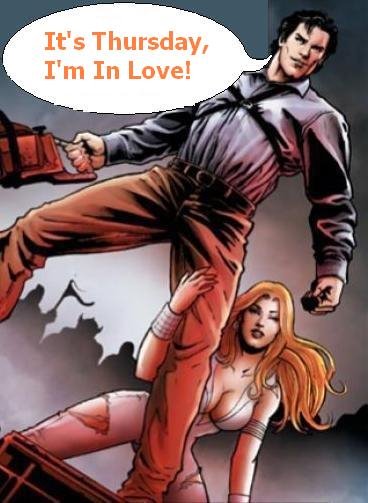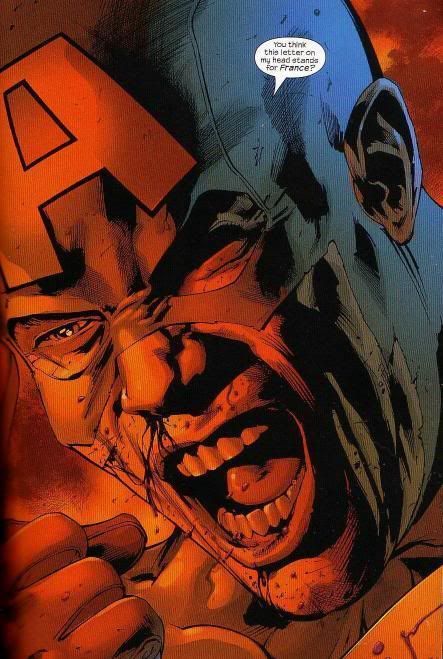I don't have them yet, but his Strangers in Paradise series is something I've always WANTED to purchase and collect. I'm just waiting for a mega-sized omnibus to be printed so I can get the series in one go, instead of those handy paperbacks they have out now.
So of course, I'm excited about his work on Marvel Universe characters, as well as any new series he's going to come up with. Will I buy the single issues? Probably not. But I'll wait for everything to be collected in a single handy TPB or HC, THEN buy that.
Though issue #1 of his new series, Echo, has a FOIL cover! And I do love me some foil gimmicky covers!
AN ‘ECHO’ FROM TERRY MOORE
The Strangers in Paradise writer-artist returns with a new indie series in March and tells why the foil cover on issue #1 isn’t just a gimmick
By Brian Warmoth | Posted November 26, 2007 12:00 PM |
Even over a long-distance call to Texas, the anticipation in Terry Moore’s voice is enough to inspire a smile. The indie comic book veteran concluded his epic 90-issue series Strangers in Paradise in June, and waited until November—long after announcing his runs on Runaways and Spider-Man Loves Mary Jane at Marvel—to reveal the title of his new self-published project. That project is Echo, the story of a single mom and a mysterious event about which Moore remains tight-lipped.
Moore unveiled the cover to Echo #1 on his blog last week, and his announcement did just what the title implied that it should throughout comics readers’ blogs. Moore picked up the phone at his Texas studio shortly after his online reveal and offered a few details about the woman on the cover of Echo #1 and what his new series will look like compared to SiP.
WIZARD: How long has Echo been in the works?
MOORE: I’ve been working on this for about four months now. When I stopped SiP, I had a drawer full of ideas, and I thought, “I’ll just pick one of those next,” but when I looked at them, none of them seemed current enough to me. They just didn’t feel right. I scratched all of that, sat down, cleared my head and wrote something new.
Has this affected any of your Marvel work at all, or is that still all on track?
MOORE: I started the Marvel arrangement before SiP ended. Even then, in the very first conversation I told Joe [Quesada], “Look, I want to write some books at Marvel while I’m making my new series. He said, “That’s very cool. I understand.” So it was always going to be this way.
Was there anything you were waiting on to fall into place before you started work on Echo?
MOORE: I thought that I was going to start earlier. I finished SiP in May. I pictured myself getting started in the summertime. There was the delay because I went through the process of eliminating all of these other projects. Then I thought I was going to do this book called Motorgirl. I was talking about Motorgirl on my blog, and I drew up an outline, and I did up a sketch. Then somebody e-mailed me and said, “We’re doing that already.” So I had to put that one away and start from scratch, but it’s been good because the more distance I put between myself and SiP, the more I feel less connected to it and I feel like I’m planted in today and what’s new.
How does your approach to this one feel different from SiP?
MOORE: The difference is that I’m really excited that I’m making a character that is grounded in today and right now. This story is very contemporary, very modern. I guess that she lives in the same world that [Strangers in Paradise] did, but it’s a different setting, a different state. Different things are going on. It all feels very fresh to me.
Has anything changed in your life that you think affected how you’re writing Echo versus how you approached Strangers in Paradise?
MOORE: Yes, actually, and I’ll be very upfront with you about this. [Laughs] You’re the first one I’ve told this to. In SiP, I just wrote it as I went, so it was very much a sort of stream-of-consciousness, performing-art type of thing. But when it was all said and done, the biggest weakness I had on SiP was plotting. Maybe the plotting wasn’t so tight. On [Echo], I have worked very hard on my plot. Whereas on SiP, I didn’t let anybody else have any input at all. On this one, I’ve been showing my plot to people and saying, “What do you think? Show me the holes. Help me. Help me.” Hopefully I’ve been able to strengthen one of my weaknesses.
Do you see any changes in your art style?
MOORE: The art in Strangers in Paradise changed so much just over the last year and a half, I’m in a place art-wise now that I never was in Strangers in Paradise. I really feel like I’ve grown as an artist and that this book is getting a different artist than SiP had. We’ll just have to see what happens. I still feel the freedoms in my head to play with the art styles and do whatever is required to make the story work. I’m not a very rigid disciplinarian as far as things having to match or look the same. Hopefully this book will find a new batch of readers that are not familiar with all of that, and they’ll find it refreshing.
You might have already answered this, but what’s the biggest challenge for you in this book versus Strangers in Paradise?
MOORE: Yeah, on Strangers in Paradise, all I had was character goals. Then, I made a plot to fit that. On this book, I’ve plotted out the first 20 issues, as if I was plotting a movie. Now, I’m going to be working on top of a very solid foundation and sequence of events that are all very logically thought out. Then I’ll just do my character thing on top of that. Hopefully, it’s a stronger package and more appealing to a mainstream audience. SiP had a lot of elements in it that maybe not everybody is interested in. This book is a little different in that I think it’s going to be a lot more approachable to the general reader.
Speaking of package, why the silver foil cover on the first issue?
MOORE: The first cover shows her standing in the middle of a downpour of these drops. That’s not rain, and it’s not hail. It all comes to play in the first issue.
What can you say right now about her as a character?
MOORE: I can tell you that she’s in her 20s and she lives alone in Yosemite National Park in California. When we find her, she has a husband, but he’s estranged. Everything in her life is on the rocks, going poorly. Her credit’s shot; the bills aren’t paid. She and her daughter are sharing the same food. She’s a very, very likable person, but she’s alone.
What are your expectations for the length of this series?
MOORE: I’ve thought through the first three storyarcs, which are all one part, and the first storyarc is 18 issues long, which is divided into three parts. Basically, I have three trade paperbacks all plotted out.
Do you feel like your audience expects you to do a female lead now? Do you particularly avoid male leads, or do you just prefer female leads?
MOORE: If I just sit down and do what comes naturally, I default to a female lead right now because that’s where my interests are. I’m more interested in women than men, and it comes out of me this way in my stories. I think there are more books with male leads than female leads, so it’s good for me to help contribute to the underdog.



No comments:
Post a Comment